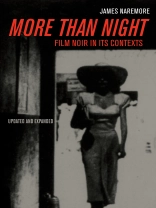‚Film noir‘ evokes memories of stylish, cynical, black-and-white movies from the 1940s and ’50s—melodramas about private eyes, femmes fatales, criminal gangs, and lovers on the run. James Naremore’s prize-winning book discusses these pictures, but also shows that the central term is more complex and paradoxical than we realize. It treats noir as a term in criticism, as an expression of artistic modernism, as a symptom of Hollywood censorship and politics, as a market strategy, as an evolving style, and as an idea that circulates through all the media. This new and expanded edition of More Than Night contains an additional chapter on film noir in the twenty-first century.
Inhaltsverzeichnis
List of Illustrations
Preface to the 2008 edition
Acknowledgments
Introduction: This Is Where I Came In
1. The History of an Idea
Noir Is Born: Paris, 1946–1959
Darkness Everywhere
2. Modernism and Blood Melodrama:
Three Case Studies
Believing in Nothing
Sympathy for the Devil
The Death Chamber
3. From Dark Films to Black Lists:
Censorship and Politics
Bourbon with a Bourbon Chaser
The Snakes Are Loose
After 1947
4. Low Is High: Budgets and
Critical Discrimination
B Pictures versus Intermediates
Post-B Pictures
5. Old Is New: Styles of Noir
Black and White and Red
Parody, Pastiche, Fashion
6. The Other Side of the Street
Asia
Latin America
Africa
7. The Noir Mediascape
8. Noir in the Twenty-first Century
Legends and Lists
Further Research
More Styles of Noir
Noir Never Dies
Notes
Bibliography
Index
Über den Autor
James Naremore is Emeritus Chancellors‘ Professor of Communication and Culture, English, and Comparative Literature at Indiana University. His books include Acting in the Cinema, The Magic World of Orson Welles, The Films of Vincente Minnelli, and On Kubrick.












